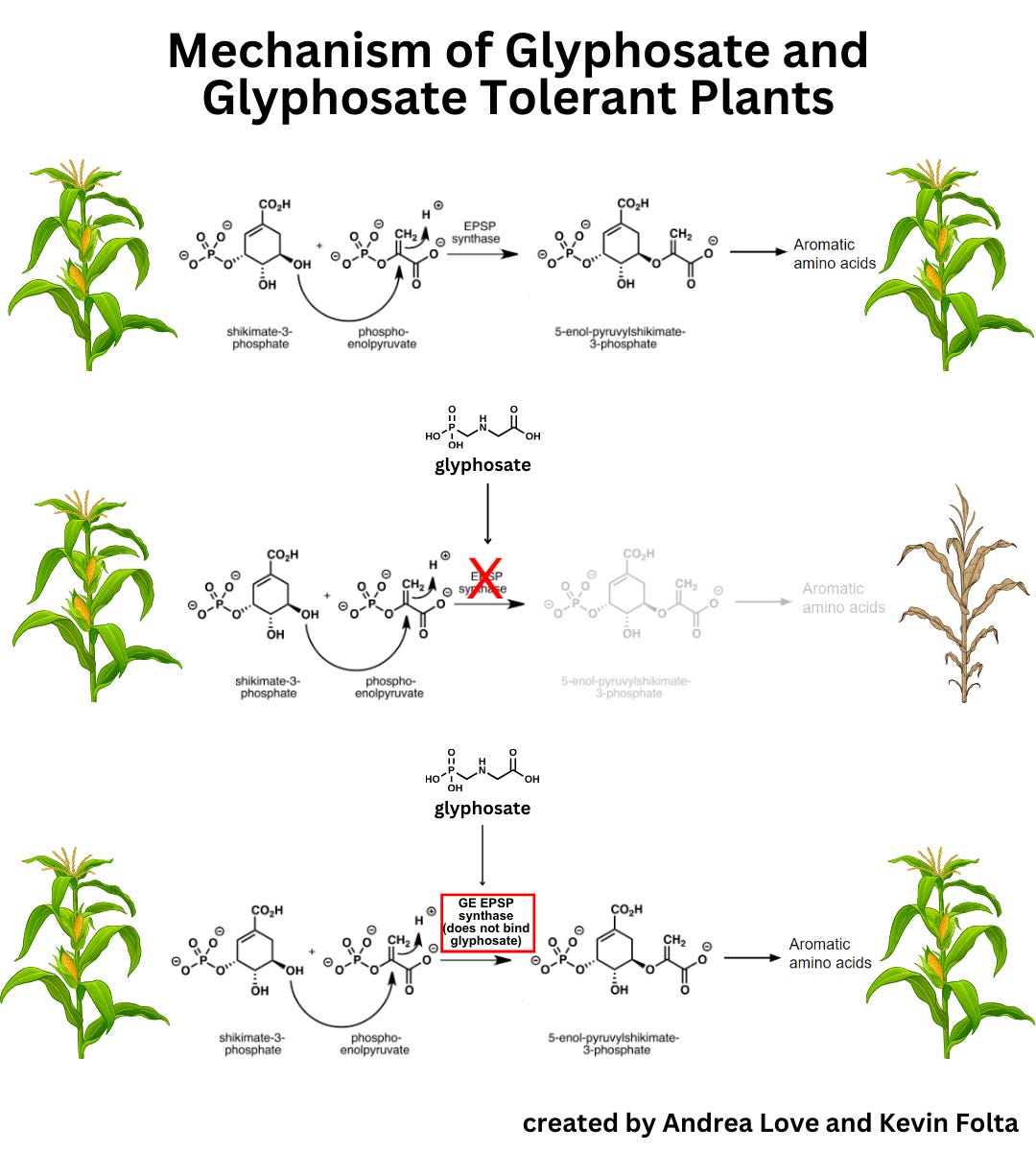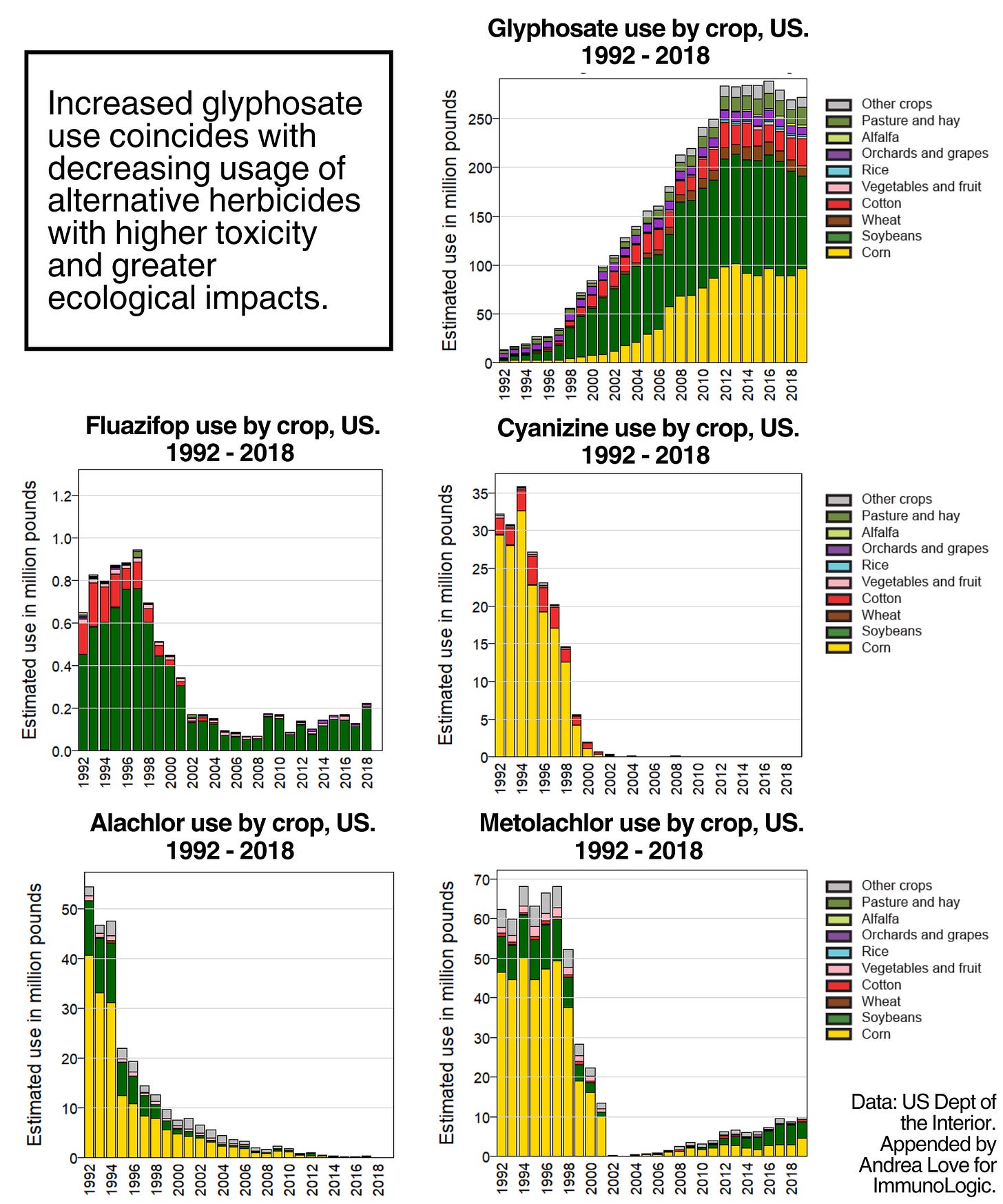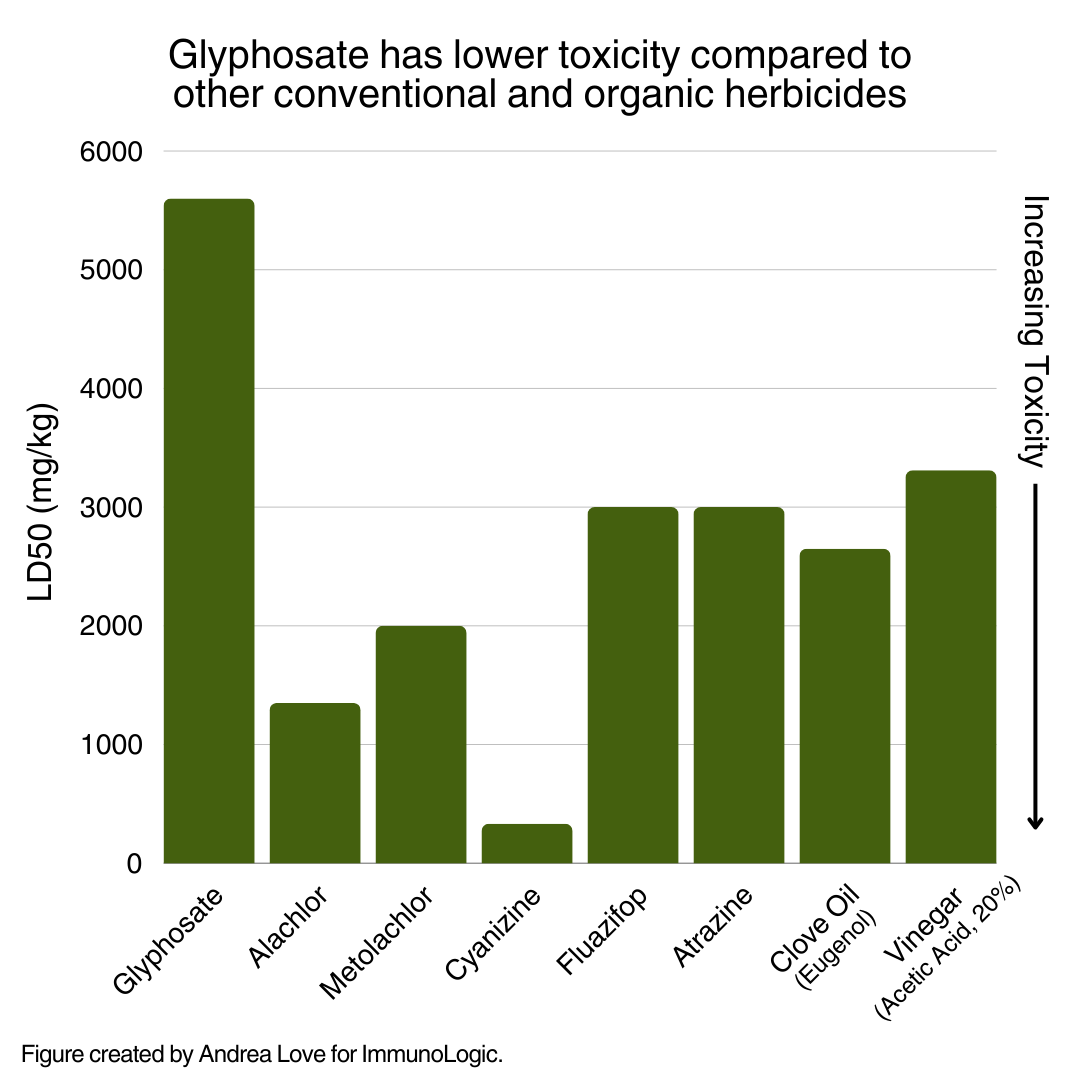There is possibly no chemical more vilified in modern culture than glyphosate. This chemical is plagued with coordinated disinformation campaigns, lawsuits, anti-science activist groups, and clickbait media headlines.
Glyphosate, the most widely used herbicide in the world, is the poster child for chemophobia. So much so that most scientists can’t even discuss tangential topics like organic farming and genetic engineering technologies without someone derailing the conversation to fixate of false beliefs related to glyphosate.
There is over 30 years of data that demonstrate glyphosate does not pose a risk to human health, both to farm workers through application or through trace dietary exposure.
There is over 30 years of data that demonstrate that glyphosate has far less ecological impact than other herbicides that would be used in its absence.
ozens of scientific expert agencies around the world routinely review the data as it relates to glyphosate and continue to uphold this conclusion.
But anti-science organizations like Moms Across America, Children’s Health Defense, the Environmental Working Group, and others have spread lies about glyphosate for nearly as long. Even though their claims don’t hold up to scientific scrutiny, their fear-laden statements cause public outcry which erodes scientific progress and hinders technological development.
The problem? Misinformation about glyphosate - and related topics - are a danger to public health.
That’s why Dr. Kevin Folta, and Dr. Nicole Keller and I wrote a feature article for Skeptical Inquirer that tackles the science of glyphosate, the history of its use, and 10 common claims that circulate in pop culture.
Glyphosate is a broad-spectrum herbicide that targets an enzyme found in plants.
There are other herbicides that exist that are not broad spectrum, which means that often, they have to be used in combination in order to effectively kills weeds in crop fields. For example, fluazifop is a selective herbicide that targets grasses, whereas clopyralid is a selective herbicide that targets broadleaf weeds like clovers.
The development of glyphosate-tolerant crops allowed farmers to use a single herbicide to effectively target all of the weeds that would strangle these specific crops, while the crops themselves would be able to grow. In doing so, that eliminated the need for additional herbicides, many of which are of greater concern for human health and ecological health. In the US, we have glyphosate-tolerant crop options for corn, cotton, soybeans, alfalfa, canola, and sugar beets. Glyphosate isn’t widely applied to non-tolerant crop fields, contrary to what many people believe, because that would kill the plants you’re trying to grow.

Why do we even use pesticides anyway?
Glyphosate has replaced herbicides that pose greater risk and would need to be used in combination.
The context there is that glyphosate use has increased while the use of other herbicides has decreased. What that means is that glyphosate has replaced other herbicides, so farmers aren’t just applying glyphosate for fun, they’re doing it to protect crop yields.

And why is glyphosate preferred over many of these herbicides that had substantial declines in use over the last several decades? Well, because glyphosate is safer for humans and the environment.
Glyphosate has lower toxicity than both organic and conventional pesticide alternatives.

When we talk about toxicity, the dose (and route of exposure) make the poison. Here, LD50 values displayed are the 50% lethal dose in milligrams per kilogram of body weight by ingestion. Remember, anything can be toxic - and non-toxic - at a certain exposure. A higher LD50 value means you’d need to ingest more of the substance to experience the toxicity effects.
Glyphosate has an acute oral LD50 of 5,600 mg/kg. This means, a person weighing 70 kg (154 lb), would need to ingest 392,000 milligrams (13.82 ounces) of concentrated glyphosate to experience acute toxicity.
And to get ahead of things, glyphosate does not cause cancer, Celiac disease, or other health conditions frequently blamed on it.
Some other herbicides used or previously used in conventional agriculture include:
Alachlor, which functionally is not used any longer, has an acute oral LD50 of 930-1,350 mg/kg; roughly 6 times more toxic than glyphosate.
Metolachlor, used in a much more restricted fashion since the implementation of glyphosate, has an LD50 of roughly 2,000 mg/kg; just shy of 3 times more toxic than glyphosate.
Cyanizine, which hasn’t been permitted to be sold in the US since 2002, has an acute LD50 of 182-332 mg/kg; 30 times higher toxicity than glyphosate. It is also estimated to have a lower chronic toxicity as a result of repeated exposures.
What about herbicides used in organic farming? They’re all natural, they must be safer, right?
Acetic acid is used at 20% concentration in vinegar-based organic herbicides. The acute oral LD50 of 20% acetic acid is 3,310 mg/kg. That means acetic acid is 1.7 times more toxic than glyphosate.
So, that same 70 kg person would only need to ingest 8 ounces of 20% acetic acid for acute toxicity to occur.
Interesting, because people do shots of apple cider vinegar for purported health benefits, right? Now, household cooking vinegar is usually around 5-6% acetic acid, but yes, you can experience toxicity of “all natural” substances at lower doses than substances that are vilified because they are deemed “toxic” by public outcry.
Clove Oil, specifically Eugenol, another organic herbicide, has an LD50 of 2,650 mg/kg. That means clove oil is 2.11 times more toxic than glyphosate.
Now, I don’t use these examples to suggest these herbicides are cause for concern, but as an illustration: why is pop culture fixated on glyphosate when it is demonstrably safer than other chemicals used to control weeds?
The answer: targeted disinformation from organizations that make a lot of money off these falsehoods.
Glyphosate also does not pose a substantial environmental risk.
Glyphosate is rapidly broken down in the soil by microbes and does not bioaccumulate or contaminate groundwater. Concerns about non-target specie effects in bodies of water relate to surfactants added to glyphosate for application, not the glyphosate itself, which is why there are regulations about pesticide use near bodies of water.
Other claims, such as glyphosate being responsible for killing bees are unsupported by real-world evidence. In reality, laboratory tests where bees were exposed to dramatically higher levels of glyphosate showed some interference with foraging behaviors, but this was also shown to be irrespective of glyphosate, and seems to be more related to some stabilizing ingredients.
There is also no evidence that glyphosate harms soil microorganisms. In fact, use of glyphosate and genetically engineered crops can reduce the need for tilling and disrupting top soil, which actually promotes nutrient retention, minimizes erosion, and reduces runoff, facilitating improved soil health.
Crops and produce items aren’t doused in glyphosate.
This is why the misinformation propagated about conventional fresh produce items is so absurd. Organizations like the AAP suggest that people should buy organic produce to avoid “pesticides” on produce items, yet finished produce items aren’t treated with pesticides. Pesticides - whatever the type - are applied during the growing - you don’t need to target pests once the finished product exists! (And yes, organic produce is also grown with pesticides, I will keep repeating that in perpetuity).
Levels of glyphosate that you might find on finished food items are in the parts per billion and parts per trillion levels. These are miniscule quantities that would never pose any sort of risk to anyone’s health.
That’s why expert scientific and regulatory agencies around the world have all concluded glyphosate does not pose a risk to human health and is safe for use. These include:
Health Canada, The European Commission, The US Environmental Protection Agency, the WHO and FAO Joint Expert Committee on Food Additives (JECFA), the US National Toxicology Program, the European Food Safety Authority, the French Agency for Food, Environmental and Occupational Health & Safety (ANSES), the German Federal Institute for Risk Assessment (BfR), the Swiss Federal Food Safety and Veterinary Office, the Australian Pesticides and Veterinary Medicines Authority, the Food Safety Commission of Japan, the Brazilian Health Regulatory Agency (ANVISA), the New Zealand Environmental Protection Authority, the Korean Rural Development Administration, the WHO’s Drinking Water Guidelines, the WHO’s International Programme on Chemical Safety, AND the US National Institutes of Health, Centers for Disease Control and Prevention, and Department of Health and Human Services under US Agricultural Health Study.
In fact, the ONLY scientific entity that plants a seed of doubt about glyphosate is the WHO’s International Agency for Research on Cancer (IARC), the only one that does not assess risk based on realistic exposure. IARC only performs a hazard assessment, discussed here, and even IARC does not conclude glyphosate poses a health risk to humans.
Anti-science messaging is louder, but not more credible.
Unfortunately, people confuse loud voices and broad online reach with legitimacy. That’s made worse when media outlets and policymakers look to these organizations that misrepresent information and mislead people for advice.
And what’s their end game? Get glyphosate banned? Then what?
These organizations don’t understand the complexity of agriculture. Do they think that if glyphosate is no longer permitted then farmers will just - not use anything to control weeds? Because that isn’t the case. Farmers will have to use something else instead, and it likely will be one or more of the options noted above, all of which have more potential risk associated with their use than glyphosate.
What we need now, more than ever, is to put an end to anti-science rhetoric that hinders technology development and implementation that is aimed to improve health and science.
Whether it is anti-vaccine rhetoric, eroding trust in evidence-based medicine while promoting wellness interventions, opposition to genetic engineering in both agriculture and biomedical spaces, climate change denialism, demonization of food ingredients, and more.
These beliefs are fundamentally founded in chemophobia as a result of disinformation that is created to scare people about something that doesn’t pose a legitimate risk. And all of it harms individual health, society, and the planet.















